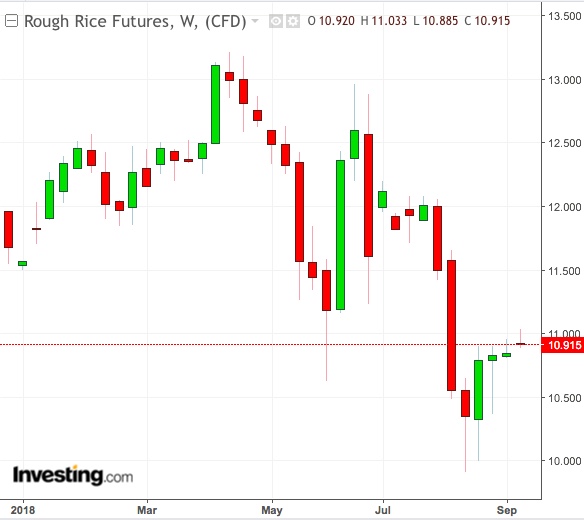Rough Rice Futures are on a cusp of a rally that could return the market to June highs of above $12 per hundred pounds (cwt), technical and fundamental readings show.
But the US Department of Agriculture says American prices for the grain are too high and need discounting to capture the larger export market share the USDA aspires for the marketing year 2018/19.
Can both be achieved?
Yes, say rice analysts and traders, who add that the two are quite distinct targets.
“One is the futures price, which is the price US farmers get for their rice,” said Shawn Hackett of Boca Raton, Florida-based agricultural markets consultancy Hackett Financial Advisors. “The other is the price that US rice is sold to the world at.”
Rough Year Thus Far For Rice Futures
It has been a rough year for US rice futures, beset with volatility since they hit a near 7 percent gain in January.

In Monday’s trade, the most active November rice contract on the Chicago Mercantile Exchange settled at $10.92 per cwt. While that puts it up nearly 1 percent for this month, it’s only a modest recovery from a 9 percent drop in August. If the market retains its upward trek, it would be its third month of gains in four. Yet for the year, it is down almost 6 percent. Hackett said:
“But all these might be changing as we see sizeable buy-signals in rice right now as we approach harvest season...We traded consistently in the $12.00-$12.50 (cwt) range in the first half of the year. That’s certainly a target to revisit. It would also be typical for a post-harvest rally.”
Jack Scoville, lead grains trader for Price Futures Group in Chicago, said he expects the market to be restrained for a while before picking up to reach between $11.50 and $11.75 cwt.
“There seems to be very good crop in Texas and Louisiana, and we’re starting to expand in places like Arkansas too. I think that’s going to keep the market under a little bit of a pressure here over the next two to three weeks, before a breakout can happen.”
“Strong Buy” Call On Technicals
Backing the prognosis for higher futures prices is Investing.com’s daily technical outlook, which has an immediate “Strong Buy” on US rough rice. The recommendation shifts to a sell only when the November contract reaches between the 50-day moving average of $11.262 and 200-day average of $11.993.
Technicals aside, global rice output may be limited next year by the 2019/2020 El Nino weather phenomenon that could bring drought and stress to crops in Asia.
The US-Mexico Free Trade Agreement announced last month could also be shaping as a positive for rice. Hackett added:
“While rice was never really under the threat of Mexican tariffs before that Agreement, the sum effect of the deal is that it’s become a fundamental boost for all grains traded between the two countries...And that includes rice.”
Nathan Childs, senior rice economist at the USDA Economic Research Service, was quoted telling an agricultural Webinar recently that US rice exports had potential to rise by 13 percent in the 2018-19 marketing year. But that still fell short of their true reach, he added. The reason for that: Venezuelan, Chilean and Paraguayan rice, which were more competitively priced than the American product.
Export Challenges
Childs used Mexico—the largest buyer of US rice, which purchased 900,000 metric tons in 2017—as a reference. “The US was probably once 99 percent or a rock solid 95 (percent in control of the Mexican market). We’re probably not even at 80 percent of that market now.”
While US rice shipments to its northern neighbor has eroded, “South American exporters continue to gain market share in Mexico,” said Childs, adding that American export prices had to drop to bridge the difference.
USDA records on rice shipments show that exporters had been cutting back on prices, though not as much as desired. The California 2017/18 all-rice season average farm price (SAFP), for instance, was lowered to $16.60 per cwt in August from July $16.70. Yet, the quote was well above the $14.10 for California SAFP through 2016/17.
Hackett said export prices were largely determined by Riceland Foods, the world's largest miller and marketer of rice that buys the bulk of the grain from American farmers before processing it for shipment. “The relative export price to farm has to contract on Riceland’s end if we are to achieve the shipment potential desired by the USDA.”
Mark Holt, a rice export division official at Riceland, did not immediately respond to Investing.com’s request for comment.
Scoville argued however that US rice was “pretty fairly priced for its quality”:
“It’s normal for both futures and export prices to come down this time of year because of harvest...But I don’t think we have to stay there to attract business. I think even at these current prices, we’ve been doing business and I think we’ll continue to do that.”
